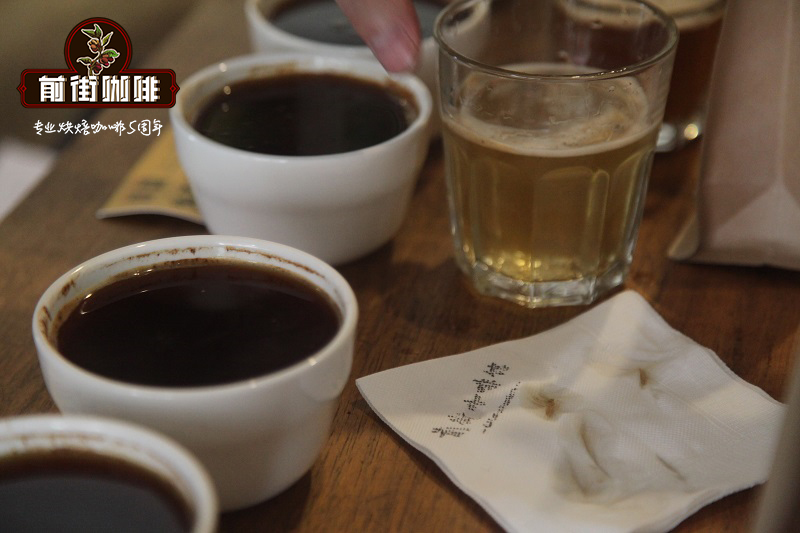Coffee flavor consists of three dimensions: aroma, taste and taste.

Coffee flavor includes aroma, taste and taste three dimensions, need to mobilize the sense of smell, taste and touch to experience, for example, the sour, sweet and bitter mentioned in the question are taste, while alcohol involves touch. Han Huaizong's "Fine Coffee" gives a comprehensive and logical introduction to the composition of coffee flavor, which has just been reviewed and transported for your reference. As the saying goes, "smell the smell in the nose, taste the five flavors in the tongue". We can taste the special taste of food through the synergistic effect of taste and smell. For example, when eating fruit, without the cooperation of smell, the attractive fruit aroma will disappear, leaving only monotonous sweetness and sour (Note 1). When we catch a cold, we always feel that the food is tasteless, one of the reasons is that after the nasal mucosa is inflamed and swollen, the odor molecules can not enter and leave the nasal cavity freely. The flavor of coffee also contains water-soluble flavor and volatile aroma. For example, Coffee Friends's mellow hand flushing actually means that when people drink coffee, they can feel the flavor of cocoa and marshmallow under the synergistic effect of taste and smell. In addition, coffee also has a taste dimension, that is, the touch of the tip of the mouth and tongue when drinking coffee.
Therefore, in a nutshell, the composition of coffee flavor has the following three elements:
1. Sense of smell: the human sense of smell can capture 2,000 to 4,000 different odors, and the recognition breadth is far beyond the sense of taste. And coffee happens to be rich in a variety of aromatic substances. The odors that can be vaporized at room temperature and perceived by us are called fragrance. These aromas are released in turn during grinding: first the most volatile sour, floral, citrus and herbal aromas, then moderate volatiles such as caramel, chocolate, cream and cereals, and finally low-volatile spices, resins, cunninghamia lanceolata, choking and scorching flavors. Fragrances that require high temperatures to volatilize will be released when coffee powder comes into contact with hot water, which is called aroma. In addition to the pleasant aromas of sweet and sour, taffy, fruit, wheat tea and sawdust, the smell of rancidity, fuel consumption and tar will also be released at this stage. We can inhale these aromas directly and feel the dry and wet aroma of the coffee. This process of sniffing out the smell of the outside world by the nose is called "prenasal smell" (orthonasal olfactory). After the entrance of the food, some gasification will enter the nasal cavity from the mouth through the nasopharyngeal canal and be perceived by us. Because these substances are released in the mouth, it is easy to be mistaken for the taste of the tongue, but it is our "post-nasal smell" (retronasal olfactory) at work. For example, some coffee has aromas of flowers and caramel on the mouth, which is not the sweetness of the fruit tasted by the taste buds, but the sense of smell captures the aroma of aldehydes / aldehydes rising into the nasal cavity. The researchers found that the sense of smell in front of the nose was more sensitive and more sensitive to smell, but the sense of excitement and pleasure caused by the sense of smell behind the nose was stronger. Therefore, when many people taste wine and smoke cigars, they often exhale from the nasal cavity, "through the back door" to increase the fun. So, the next time you drink coffee, you can try to shut up and exhale slowly and experience the fragrance of the nasal cavity.
two。 Taste: the so-called "taste" usually refers to the process in which the taste receptor cells in the taste buds recognize different taste stimuli, encode neuroelectrical signals and transmit them to the cerebral cortex, and eventually become sour, sweet, bitter, salty and fresh. Coffee does not contain delicious substances, but not only bitter taste, but a collection of sour, sweet, bitter and salty four tastes > acid: coffee beans contain more than 30 kinds of organic acids, among which phenolic acids, fatty acids and amino acids have the greatest influence on the taste. Aliphatic acids such as citric acid, malic acid, acetic acid and lactic acid can increase the brightness of coffee, especially in the neutralization of sweet substances, showing the sweet and sour flavor of fruit. Sweet: sucrose, ethanol, glycols and amino acids in raw beans will undergo caramelization and Maillard reaction during baking, resulting in water-soluble sweet substances such as caramel and furan compounds. Caramelization is a dehydration or degradation reaction that occurs when sugars are heated to the melting point, while Maillard reaction is more complex, which refers to a series of degradation and polymerization between monosaccharide carbohydrates and proteins. In addition to sweet substances, these reactions are also the source of attractive aromas such as nutty, caramel and chocolate. Bitter: caffeine, trigonelline, fatty acids and quinine in coffee beans naturally have a slightly bitter taste. But "black coffee must be bitter" is a myth-the frowning bitterness comes from the bitterness of chlorogenic acid lactone, the bitterness of baked carbides and the mixed bitterness of defective beans, which often means that there is something wrong with the selection and baking of coffee beans. Salty: the salty taste of coffee comes from various minerals, such as water-soluble sodium, lithium, potassium, bromine, iodine compounds and so on. However, salty taste is often invisible in the interaction with other flavors, which is why many people can't drink salty taste. The obvious salty taste means that there is less organic matter, which may be overbaked or the coffee beans are no longer fresh. Surprisingly, the highest proportion of all soluble flavors is actually sweet, with a full 39%. On the other hand, the bitter substances that are most easily caught by the sense of taste account for only 26.4%, in fact, because bitter, salty and sour flavors are very easy to interfere with, and sweetness is the most valuable flavor of coffee-only when coffee beans with higher-than-average sucrose and amino acid contents are perfectly baked can sweetness jump out. Therefore, as far as coffee taste is concerned, sweetness is the most precious. Mild bitterness and soft acid can increase the richness of the taste spectrum, while heavy bitterness and obvious salty taste are negative factors.
3. Taste: thick and astringent coffee has two dimensions: thick and astringent. Body, also known as stickiness, thickness or smoothness, refers to the touch of colloids formed by coffee oil combined with proteins, fibers and other tiny suspensions that do not dissolve in water. After drinking coffee, slide your tongue through the upper jaw and mouth, and feel the feeling of oily sliding, which is this "body".
Note: this is a wrong demonstration. Remember when we mentioned last time that coffee made by different extraction methods has different thickness? Italian concentrate is extracted at nine atmospheric pressures and is rich in coffee oily fiber and tends to have a creamy smooth taste. The filter cloth and filter paper will block the gum in the coffee, so the dripping coffee tends to be clear and thick. Only with the consistency of coffee can it stand against the taste and aroma. So even if milk is added to the Italian concentrate, the flavor of the coffee will not be masked, but if milk is added to the hand-brewed coffee. The smell of the coffee is gone. In addition to the colloid in vitro, coffee also contains polyphenols such as dicaffeoylquinic acid, which is decomposed by tartaric acid and chlorogenic acid. These polyphenols are easy to bond with proteins in the mouth, creating a rough sense of astringency. Sugar can neutralize astringency, so good coffee with high sugar content will not taste astringent. If the quality of raw beans is poor or roasted too quickly, a large number of dicaffeoylquinic acid will be produced, making the coffee with a lingering astringency. If you have the misfortune to drink astringent coffee, you can add some sugar to relax. Milk is also a savior to break the sense of astringency, because polyphenols instead bind to the proteins in milk. Shrewd merchants take full advantage of this: Robasta coffee beans used in instant coffee are cheap in large bowls but high in chlorogenic acid and taste unusually astringent. What shall I do? Try to add sugar and cream to cover up the astringency! Now you can see why instant coffee is always so sweet and delicious.
Important Notice :
前街咖啡 FrontStreet Coffee has moved to new addredd:
FrontStreet Coffee Address: 315,Donghua East Road,GuangZhou
Tel:020 38364473
- Prev

What is the basic knowledge of coffee?
What's the point of a good cup of coffee? Good soaking skills and utensils are indispensable, but high-quality coffee beans are the most important element. Do you have no idea about coffee beans, or are you often spoiled by a bunch of coffee names? No matter, in the following article, we will introduce the important knowledge about coffee beans in the most easy-to-understand way. Only if there are high-quality coffee beans, there are good ones.
- Next

What are the basic substances of Taiwan coffee beans?
What are the basic ingredients of Taiwan coffee beans: moisture: the water content of Taiwan coffee beans will vary greatly according to the processing procedures of the processors themselves. The water content of raw coffee beans with film dampness is about 50%. The water content of dried coffee beans is about 1013% (normal standard), and the water content of roasted coffee beans is about 5%. The presence of water in coffee beans will affect the coffee beans because of the content.
Related
- Beginners will see the "Coffee pull flower" guide!
- What is the difference between ice blog purified milk and ordinary milk coffee?
- Why is the Philippines the largest producer of crops in Liberia?
- For coffee extraction, should the fine powder be retained?
- How does extracted espresso fill pressed powder? How much strength does it take to press the powder?
- How to make jasmine cold extract coffee? Is the jasmine + latte good?
- Will this little toy really make the coffee taste better? How does Lily Drip affect coffee extraction?
- Will the action of slapping the filter cup also affect coffee extraction?
- What's the difference between powder-to-water ratio and powder-to-liquid ratio?
- What is the Ethiopian local species? What does it have to do with Heirloom native species?

